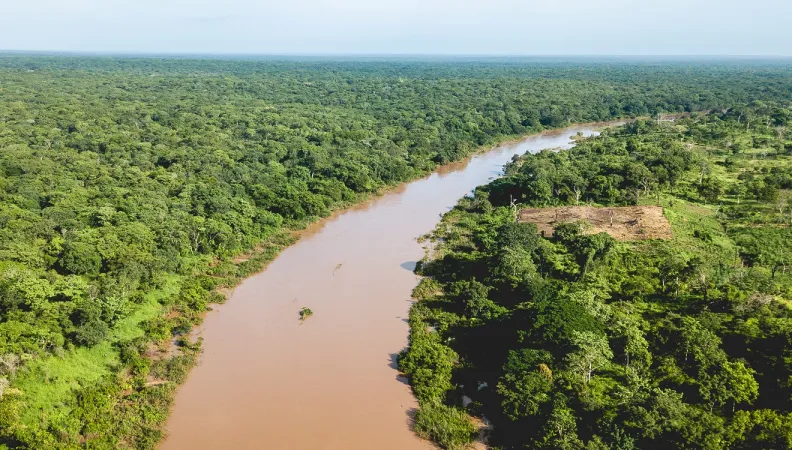Share the page
6 Good Reasons to Preserve Forests
Published on

They contribute to biodiversity and mitigate the effects of climate change and pollution – just a few of the many boons bestowed by forests worldwide. Here we review the six main reasons why we should protect them.
#1 Places of exceptional biodiversity
As earth’s massive reservoirs of biodiversity, forests have yet to reveal all their secrets. They are home to 80% of the planet’s land-based species, and a single square meter of forest floor contains an average of 1,000 different species of invertebrates.
In the Amazon, a new animal or plant species is discovered every two days. Meanwhile, on the Indonesian island of Sumatra, 400 new plant species have been identified since 1995.
But what the naturalist Jean Dorst calls our “natural capital” is in danger. In the short term, it is estimated that one in eight species will disappear. In fact, some scientists are already calling this the “6th mass extinction.” What makes this one different from the previous five, is this time, humans are the cause.
#2 Allies against global warming
“The planet is overheating: it is urgent to put it in the shade of trees,” said Nathalie de Noblet, coordinator of the Intergovernmental Panel on Climate Change (IPCC) in a recent issue of the magazine Science & Vie. Her image was well chosen, as forests represent the second largest carbon sink on the planet, after the oceans.
A tree measuring 5m3 can store five tons of CO2 on average during its lifetime. That’s equivalent to the carbon footprint of five round-trip flights from Paris to New York for a single passenger. Currently, forests absorb nearly 2 billion tons of carbon dioxide each year, or 5% of our global greenhouse gas emissions. This is far from negligible.
Forests also play a key role in replacing fossil fuels (coal, oil, gas, etc.) with biomass fuels such as wood and biogas. These latter have the advantage of being renewable and have a much more positive carbon footprint. Specifically, we could do better than now when it comes to recovery of sawmill residues, low-quality wood, and branches from three thinning.
Without forests, climate change would already be at a more advanced stage. But, thanks to forests, we can hope to curb it one day.
#3 A resource crucial for local populations
The Pwo Karen in Thailand, the Waiapi in the Amazon, and the Ntumu in Cameroon are just a few examples of forest peoples, who make up 700 million individuals worldwide. They form very disparate groups, including farmers (of cocoa or coffee for example), hunter-gatherers, itinerant producers (of products ranging from nuts to latex), and traders. But they have one point in common: they are all dependent on the fate of the forests.
And if we add the people throughout the world who use wood for household use (heating, cooking, building), plants for healing, or game and fruit for food, the number of people relying on forests to meet their basic needs rises to nearly 1.6 billion people—one-fifth of the world’s population.
#4 Bulwarks against global warming
Forests can act as bulwarks to mitigate the damage of natural hazards such as avalanches, mudslides, erosion, and flooding. They can even be effective against violent disasters: a study on the island of Palu, in Indonesia, following the 2018 tsunami, revealed that a 50- to 70-meter wide mangrove had helped reduce the height of the deadly wave from 5 m to 1 m, thereby sparing nearby villages. This mangrove proved more effective than any kind of artificial levee.
See also: Indonesia: fishermen back on their feet after the tsunami
On the other hand, forests must be sufficiently solid in order to protect against disasters. One of the reasons Portugal has suffered so many huge forest fires in recent years is that its many poorly maintained forests are mostly made up of a single species of tree that is not very resistant to fire. Sustainable and diversified forestry remains the best weapon against natural disasters.
#5 Guarantors of water quality
In the collective imagination, “spring water” is close to perfect water. Yet, it would be more accurate to say “forest water.” A study by the French National Institute for Agronomic Research (INRA) has shown that water filtering through a forest is 10 to 20 times less polluted than water harvested under cropland (where corn, cereals, or rapeseed are grown).
Forests are natural environments mostly free of pesticides and fertilizers. The micro-organisms present in their soils also ensure an efficient filtration of impurities. Moreover, forest subsoils can store significant amounts of water —up to 2 million liters per hectare, making them genuine sources of life.
#6 Levers for attracting tourists
All over the world, forests are becoming tourist attractions. The Avenue of the Baobabs, where a dozen of these gigantic trees line a road in western Madagascar, is one of the most visited attractions of the region. The Japanese island of Yakushima, entirely covered in primary forests, has seen a resurgence in visitors since it inspired the animated film “Princess Mononoke.” Meanwhile, the endless palm trees of the Cocora Valley are now a must-see for anyone traveling to Colombia.
But a report published by the Intergovernmental Science-Policy Platform on Biodiversity and Ecosystem Services (IPBES) reminds us of the need to control the influx of people into these fragile places. Walking in the forest is all right, but only on the condition that wildlife there is preserved.
Side menu
$(document).ready(function() {
$('#most_viewed_nodes_block').replaceWith($('#mi'));
});
Forests Series
Gabon: Exploiting Forests without Destroying them Preserving Africa’s Forests: Vigilance, Scientific Analysis and Regeneration Combating Deforestation in the Congo Basin Mobilizing Local Populations in Forest Management In the Struggle to Make Forests Sustainable, how Effective are Verification Systems? AFD’s 30 years of Action for Congo Basin Forests "We encourage forest operators to change their practices" Main Menu
